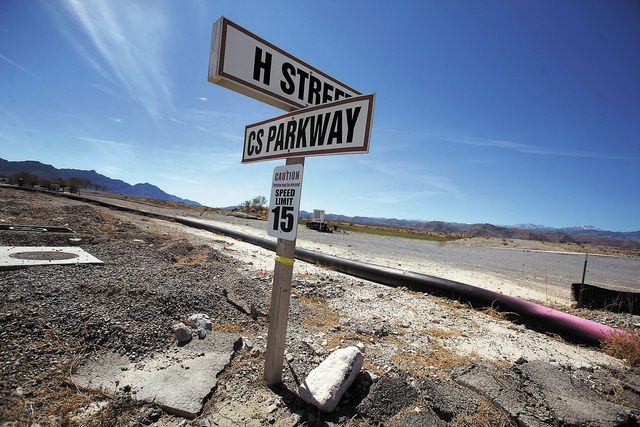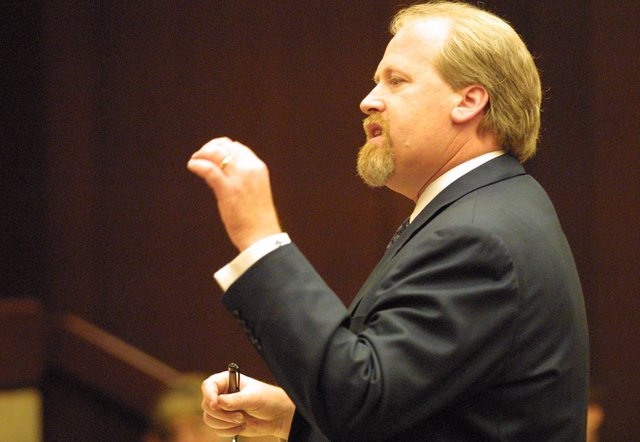Dream of Coyote Springs development still years away from reality
When it broke ground seven years ago, the Coyote Springs master plan was still a dream — a vast expanse of desert and the rumor of 150,000 homes to come.
Today, following a recession, an epic housing bust, years of internecine squabbling and, most recently, a prison sentence for a former development partner, Coyote Springs is, well, a vast expanse of desert and the rumor of 150,000 homes to come.
A bum economy and some nasty legal troubles will do that to any project.
But Coyote Springs’ troubles are especially notable both for the proposed community’s size, and for its rise-and-fall-and-possible-rise trajectory, which mirrors the wild boom-and-bust cycle that’s kept Southern Nevada in headlines across the world.
One developer involved in the project 58 miles north of Las Vegas on U.S. Highway 93 says its existing infrastructure and a “successful” golf course mean Coyote Springs is still a go. Someday. It’ll be a while before model homes materialize — the still-soft real estate market can’t support much new housing inventory now.
A local economist agreed.
“Prices have been rising here in the past year, but there’s still a large gap between the price of existing homes and the price of new homes,” said Steve Brown, director of the Center for Business and Economic Research at the University of Nevada, Las Vegas. “Rather than looking at whether we need those homes, look at whether the economics support them. There isn’t going to be much demand for new housing as long as housing prices are well below replacement costs.”
It could take up to half a decade for conditions to change enough to make Coyote Springs happen. But what’s another few years for a project that’s already been 15 years in the making?
HIGHS AND LOWS
Coyote Springs’ saga began in 1998, when Reno developer and lobbyist Harvey Whittemore dropped $23 million on 42,000 acres straddling the border of Clark and Lincoln counties. Whittemore eventually took on partners, including Pardee Homes and California-based developers Thomas Seeno and Albert Seeno Jr. By 2006, plans for the community, which has a footprint twice the size of Summerlin’s, called for 150,000 homes, nearly a dozen golf courses and perhaps even a couple of hotel-casinos.
And the time was right to talk about starting construction: The median local home price had spiked in mid-2006 to $315,000, pricing legions of working-class locals out of the Las Vegas Valley. Homes at Coyote Springs, just an hour’s drive from downtown Las Vegas, would average $100,000 less, developers said in September 2006.
Within months, though, the economy quit cooperating. The housing bubble began leaking air in early 2007, as home sales and prices deflated. Nor could a proposed community that would rely on commuters survive surging gasoline prices. Fuel costs per gallon rose from roughly $2.20 in March 2006 to $3 in September 2006. By mid-2008, local housing prices had fallen below a median of $250,000. Unemployment soared, and gasoline ran more than $4 a gallon. In September 2008, Coyote Springs’ developers said they had decided to delay construction for 18 months.
That’s when things really started to go wrong.
In January 2012, the Seenos sued Whittemore, accusing him of embezzling and misappropriating more than $40 million from their Wingfield Nevada Group Holding Co. to spend on private jet flights, home improvements and entertainment. Whittemore countersued the Seenos, alleging racketeering, extortion and threats to his family.
Those lawsuits were settled in February on terms neither side will divulge. But that wasn’t the end of legal troubles for either party. The Seenos face an ongoing investigation related to a 2010 FBI raid of their San Francisco-area offices. A Seeno sales executive pleaded guilty to wire fraud in March and agreed to testify against her employer if called before a grand jury. There have been charges of illegal septic-tank installations at the community’s golf course. And on Sept. 30, Whittemore got two years in prison and a $100,000 fine for funneling illegal campaign contributions to Senate Majority Leader Harry Reid.
That federal conviction was the most recent in a string of travails, but it’s actually the still-struggling economy that continues to rein in Coyote Springs, a Pardee executive said.
ON THE SHELF
Klif Andrews, Pardee’s Nevada division president, is the first to admit there’s not enough demand now for the project.
“It’s really on hold awaiting better market conditions,” he said. “We’re aware that legal issues exist, and we’re working to resolve those at the same time.”
Still, there’s been some infrastructure-related activity at the site in the past year or so, including connecting to the electric grid and completing a wastewater treatment facility. A Seeno spokesman said in August 2012 that the project has more than $300 million in infrastructure in place, including water and sewer lines.
The Jack Nicklaus-designed golf course is doing well, too, Andrews said, selling more than 20,000 rounds of golf a year — or 55 rounds a day — at $129 weekdays and $144 on weekends as of late October.
Nor has the scope of the project changed, Andrews said. Prices aren’t set, but Coyote Springs will still have 150,000 homes at completion, he said, and it will appeal to families looking for more affordable homes, and to retirees and military personnel who work at Southern Nevada’s bases and sensitive sites.
The question is when people can start moving in.
“(That’s) really difficult to say until we get to that point in the market,” Andrews said. “It could be two years. It could be five years.”
Local observers agree it’ll be years before the first home goes up at Coyote Springs.
Prices remain well below peak, and foreclosures are trickling slowly onto the market, lengthening Southern Nevada’s return to a balanced market, said Dennis Smith, president and CEO of Home Builders Research in Las Vegas.
“The market has to get a lot better before we see homebuilders start to go out there,” Smith said. “What’s going to change here in one year, or in two years? It’ll take at least that amount of time.”
Smith added that Coyote Springs’ best bet is to compete with Mesquite for the wave of retirees expected to head to the Sun Belt in coming years. Even then, it’ll take “major marketing dollars to combat the negative perception that has existed for the last five years about Coyote Springs,” he said.
Brown, the UNLV economist, said retirees are definitely interested in the Southwest, but it’ll be difficult for Coyote Springs to compete with Las Vegas for snowbirds. Housing here is affordable, and Las Vegas has important services such as doctors and grocery stores. Coyote Springs will have to make the case to retailers and professionals before it can reel in retirees, he said.
As the population grows, Brown said, there will eventually be demand for new, large-scale housing development in Southern Nevada. But not anytime soon: It’ll likely take three to five years for local home prices to catch up with building-replacement costs and make development viable, Brown said.
Contact reporter Jennifer Robison at jrobison@reviewjournal.com. Follow @J_Robison1 on Twitter.


















